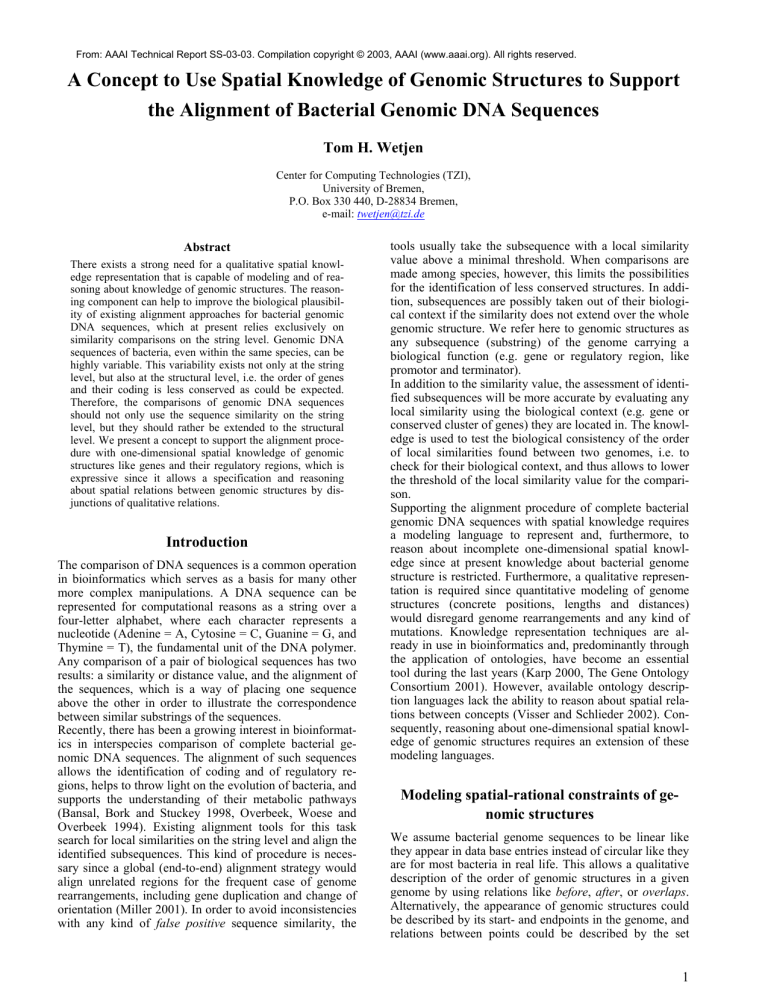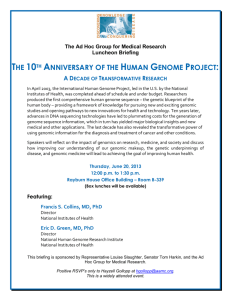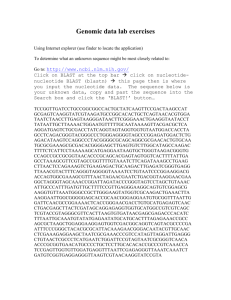
From: AAAI Technical Report SS-03-03. Compilation copyright © 2003, AAAI (www.aaai.org). All rights reserved.
A Concept to Use Spatial Knowledge of Genomic Structures to Support
the Alignment of Bacterial Genomic DNA Sequences
Tom H. Wetjen
Center for Computing Technologies (TZI),
University of Bremen,
P.O. Box 330 440, D-28834 Bremen,
e-mail: twetjen@tzi.de
Abstract
There exists a strong need for a qualitative spatial knowledge representation that is capable of modeling and of reasoning about knowledge of genomic structures. The reasoning component can help to improve the biological plausibility of existing alignment approaches for bacterial genomic
DNA sequences, which at present relies exclusively on
similarity comparisons on the string level. Genomic DNA
sequences of bacteria, even within the same species, can be
highly variable. This variability exists not only at the string
level, but also at the structural level, i.e. the order of genes
and their coding is less conserved as could be expected.
Therefore, the comparisons of genomic DNA sequences
should not only use the sequence similarity on the string
level, but they should rather be extended to the structural
level. We present a concept to support the alignment procedure with one-dimensional spatial knowledge of genomic
structures like genes and their regulatory regions, which is
expressive since it allows a specification and reasoning
about spatial relations between genomic structures by disjunctions of qualitative relations.
Introduction
The comparison of DNA sequences is a common operation
in bioinformatics which serves as a basis for many other
more complex manipulations. A DNA sequence can be
represented for computational reasons as a string over a
four-letter alphabet, where each character represents a
nucleotide (Adenine = A, Cytosine = C, Guanine = G, and
Thymine = T), the fundamental unit of the DNA polymer.
Any comparison of a pair of biological sequences has two
results: a similarity or distance value, and the alignment of
the sequences, which is a way of placing one sequence
above the other in order to illustrate the correspondence
between similar substrings of the sequences.
Recently, there has been a growing interest in bioinformatics in interspecies comparison of complete bacterial genomic DNA sequences. The alignment of such sequences
allows the identification of coding and of regulatory regions, helps to throw light on the evolution of bacteria, and
supports the understanding of their metabolic pathways
(Bansal, Bork and Stuckey 1998, Overbeek, Woese and
Overbeek 1994). Existing alignment tools for this task
search for local similarities on the string level and align the
identified subsequences. This kind of procedure is necessary since a global (end-to-end) alignment strategy would
align unrelated regions for the frequent case of genome
rearrangements, including gene duplication and change of
orientation (Miller 2001). In order to avoid inconsistencies
with any kind of false positive sequence similarity, the
tools usually take the subsequence with a local similarity
value above a minimal threshold. When comparisons are
made among species, however, this limits the possibilities
for the identification of less conserved structures. In addition, subsequences are possibly taken out of their biological context if the similarity does not extend over the whole
genomic structure. We refer here to genomic structures as
any subsequence (substring) of the genome carrying a
biological function (e.g. gene or regulatory region, like
promotor and terminator).
In addition to the similarity value, the assessment of identified subsequences will be more accurate by evaluating any
local similarity using the biological context (e.g. gene or
conserved cluster of genes) they are located in. The knowledge is used to test the biological consistency of the order
of local similarities found between two genomes, i.e. to
check for their biological context, and thus allows to lower
the threshold of the local similarity value for the comparison.
Supporting the alignment procedure of complete bacterial
genomic DNA sequences with spatial knowledge requires
a modeling language to represent and, furthermore, to
reason about incomplete one-dimensional spatial knowledge since at present knowledge about bacterial genome
structure is restricted. Furthermore, a qualitative representation is required since quantitative modeling of genome
structures (concrete positions, lengths and distances)
would disregard genome rearrangements and any kind of
mutations. Knowledge representation techniques are already in use in bioinformatics and, predominantly through
the application of ontologies, have become an essential
tool during the last years (Karp 2000, The Gene Ontology
Consortium 2001). However, available ontology description languages lack the ability to reason about spatial relations between concepts (Visser and Schlieder 2002). Consequently, reasoning about one-dimensional spatial knowledge of genomic structures requires an extension of these
modeling languages.
Modeling spatial-rational constraints of genomic structures
We assume bacterial genome sequences to be linear like
they appear in data base entries instead of circular like they
are for most bacteria in real life. This allows a qualitative
description of the order of genomic structures in a given
genome by using relations like before, after, or overlaps.
Alternatively, the appearance of genomic structures could
be described by its start- and endpoints in the genome, and
relations between points could be described by the set
1
{<, =, >}. Both kinds of one-dimensional knowledge representations (interval-based and point-based framework)
are well-known in knowledge-based systems (for an introduction see Beek 1992). When modeling, e.g. the enclosure of one structure into another, or the overlap of two
structures as it can occur between genes or regulatory
regions, only the interval-based framework meets the requirements for the representation of genomic structures.
Therefore, to qualitatively model spatial relations between
genomic structures we use Allen's interval logic (Allen
1983). There exists a set of thirteen basic relationships
denoted by I which can hold between two intervals,
namely: before (b), after (bi), meets (m), met-by (mi),
overlaps (o), overlapped-by (oi), starts (s), started-by (si),
finishes (f), finished-by (fi), during (d), contains (di), and
equals (eq). In order to represent incomplete information
between two intervals, the relations are allowed to be a
disjunction of the basic relations, i.e. any subset of I. We
then formalize one-dimensional genomic structures Gi and
Gj as binary variables on which constraints are defined.
This allows a formalization of the reasoning tasks as constraint satisfaction problems (CSP).
There are various standard algorithms to solve CSPs
(Kumar 1992). Although in the worst case, finding a consistent scenario is NP-complete for the interval-based
framework, these algorithms can work well in practice
(Beek and Manchak 1996). Golumbic and Shamir
(Golumbic and Shamir 1993) were the first to introduce
the interval-based framework into a problem of molecular
biology of practical size, namely to check if the DNA
molecule is linear in structure, by modeling sequenced
segments and testing whether they are disjoint or intersects. Beek and Manchak (Beek and Manchak 1996)
demonstrated that reasoning is tractable for this problem.
Approach for spatial reasoning about genomic
structures
One genome for which knowledge exists is taken as a
reference for the alignment and called the reference genome. Spatial knowledge of genomic structures of this
specific genome and more general knowledge is introduced into a constraint network (reference model) either
by an expert via an editor, or automatically by extracting it
from publicly available data bases. This allows for a flexible knowledge adjustment with respect to the analysis task.
We call the other genome the inquiry genome.
Prior to the identification of a consistent scenario, the
consistency of the reference model must be guaranteed.
Inconsistencies may have been caused by partial knowledge refinements, i.e. a relation set between two genomic
structures was either extended or reduced. All feasible
relations between all pairs of genomic structures have to
be found. This can be done employing the path consistency
algorithm on the constraint network (Beek and Manchak
1996).
Here, we will concentrate on how to find a consistent scenario of the local similarities identified between the reference genome and the inquiry genome. Finding local similarities is done by a standard algorithm named BLAST
(Altschul, et al. 1997).
A variable xk of the constraint network is a directed relation r between exactly two genomic structures Gi and Gj:
xk = r(Gi, Gj), with r ∈ I and Gi, Gj ∈ G. We call the variables of the reference model the reference variables, denoted as x. On the other hand, the relations measured in the
inquiry genome are called the inquiry variables, denoted
as y. However, the possibility to identify local similarities
on the string level for each genomic structure of the reference genome decreases when comparisons among species
are made. Thus, we compare only the sets of variables for
which at least one local similarity hit exists. The remaining
sets of all variables for the comparison are denoted as X
and Y, respectively.
To test the equality of the biological context, a match between the reference model and the inquiry genome has to
be performed. This equality holds, if for each x ∈ X a y ∈
Y exists, so that all relations between two variables r(yi, yj),
with yi ≠ yj ∈ Y, are consistent with the relations defined in
the reference genome. Hence, all y of a relation rk are considered domains of the x which constitutes the relation rk.
Binary constraints are defined as tuples of variables in
order to check for consistent matches. Eventually, the
backtracking algorithm has to find an instantiation for each
variable x, which satisfies all constraints. Figure 1 illustrates an example of the approach.
Conclusions
We have described a concept to support the alignment of
bacterial genomes with respect to spatial knowledge of
genomic structures. The concept supports the alignment
procedure by checking the biological context of identified
subsequences with respect to their order in a reference
model. As a result, the threshold of the local similarity
value can be decreased thus making the identification of
less conserved structures among species more efficient.
We have shown that for our approach spatial reasoning is
an important prerequisite in order to check for inconsistencies within the knowledge provided. Inconsistencies may
be caused by user-refinements of the knowledge, i.e. partial extensions or restrictions of the relationships. The
reason is that spatial knowledge normally exists about
special genomic structures (e.g. the order of the parts of a
gene cluster), but not about all relationships to all other
existing structures within the same genome. It is not reasonable to adapt by hand the quantity of all relationships
for a user. The same holds for knowledge provided by
public data bases, since it is essentially the direct spatial
order which is annotated.
The concept described increases the computational expenses of bacterial genome alignments, on the other hand,
the biological plausibility of the analysis is improved and
new knowledge about the structures can be derived. The
accuracy of the concept highly depends on the amount and
the precision of the provided knowledge, i.e. the genomic
structures and their relations. Thus, a lot of work is required to accurately model the structure of a reference
genome. This work needs to be supported by a userfriendly editor which allows an intuitive modeling of spatial knowledge. However, once a reference genome is
modeled accurately it may prove helpful to many analyses.
Figure 1 Examples of a) the order of genes in a reference genome (dotted line represents the DNA sequence; numbers account for the
start- and end-positions of the genes); b) incomplete knowledge of the order of the genes (all permutations are allowed) after instantiating
the reference model (the relation set {b, bi, m, mi} is provided between all genes, which is not shown); c) knowledge refinement for a
conserved gene pair nrgA and nrgB; d) local similarities between the reference genome (Ref.) and an inquiry genome (Inq.) (numbered 14). There exist two local similarity hits (1 and 3) for nrgB. However, only the local similarities 2, 3, and 4 are consistent with the knowedge modeled in the reference model of c).
The structure of bacterial genomes is highly diverse
across species and the dynamic of genome organization is
not fully understood yet (Andersson 2000, Casjens 1998).
Thus, when comparing phylogenetic distanced species, the
knowledge provided for the reference genome might be
over-constrained, i.e. the relation sets between genomic
structures are reduced too much (e.g. for clusters of
genes). Therefore, we plan to extend the approach by the
mechanism of constraint relaxation, i.e. trying to satisfy a
maximal number of constraints (for an overview see Freuder and Wallace 1992).
References
Allen, J. F. 1983. Maintaining Knowledge about Temporal
Intervals. Communications of the ACM 26:832-843.
Altschul, S. F., Madden, T. L., Schäffer, A. A., Zhang, J.,
Zhang, Z., Miller, W. and Lipman, D. J. 1997. Gapped
BLAST and PSI-BLAST: A New Generation of Protein
Database Search Programs. Nucleic Acids Research
25:3389-3402.
Beek, P. v. and Manchak, D. W. 1996. The Design and
Experimental Analysis of Algorithms for Temporal Reasoning. Journal of Artificial Intelligence Research 4:1-18.
Casjens, S. 1998. The Diverse and Dynamic Structure of
Bacterial Genomes. Annu. Rev. Genet. 32:339-377.
Freuder, E. C. and Wallace, R. J. 1992. Partial Constraint
Satisfaction. Artificial Intelligence 58:21-70.
Golumbic, M. C. and Shamir, R. 1993. Complexity and
Algorithms for Reasoning about Time: A Graph-Theoretic
Approach. J. ACM 40:1108-1133.
Karp, P. D. 2000. An Ontology for Biological Function
Based on Molecular Interactions. Bioinformatics 16:269285.
Kumar, V. 1992. Algorithms for Constraint Satisfaction
Problems: A Survey. Artificial Intelligence 13:33-44.
Andersson, S. G. E. 2000. The Genomic Gamble. Nature
Genetics 26:134-135.
Miller, W. 2001. Comparison of Genomic DNA Sequences: Solved and Unsolved Problems. Bioinformatics
17:391-397.
Bansal, A. K., Bork, P. and Stuckey, P. J. 1998. Automated Pair-Wise Comparisons of Microbial Genomes.
Math. Modelling and Sci. Computing 9:1-23.
Overbeek, J., Woese, C. R. and Overbeek, R. 1994. The
Winds of Evolutionary Change: Breathing New Life into
Microbiology. Journal of Bacteriology 176:1-6.
Beek, P. v. 1992. Reasoning about Qualitative Temporal
Information. Artificial Intelligence 58:297-326.
The Gene Ontology Consortium 2001. Creating the Gene
Ontology Resource: Design and Implementation. Genome
Research 11:1425-1433.
3







